iPhone 5 was released and it has all the features and improvements that people were looking for. The design is lighter and has a larger display, and battery life has also improved. This is an upgrade from the iPhone 4S.
Pluses
- Beautiful, sophisticated design
- Thinner, lighter
- Bigger screen, still easy to hold
- Great productivity
- Impressive battery life
Cons
- Lightning connector incompatibility
Apple iPhone 5 Specifications

- Release date: 2012, September
- Colors: Black/Slate, White/Silver
- Dimensions: 123.8 x 58.6 x 7.6 mm.
- Weight: 112 g.
- Screen: 4" in, 640 x 1136, LED-backlit IPS LCD
- Camera : Single, 8MP
- Chipset: Apple A6 (32 nm)
- CPU: Dual-core 1.3 GHz Swift (ARM v7-based)
- Memory: 16/32/64 GB, 1 GB RAM DDR2
- Battery: 1440, Non-removable Li-Po
- Network: GSM / CDMA / HSPA / EVDO / LTE
- Operating system: iOS 6, upgradable to iOS 10.3.3
- Sensors: Accelerometer, gyro, proximity, compass
If you are curious to find out all the details before reading the full review, visit the page for Apple iPhone 5 Specs, where you will find even the smallest detail about the phone.
Apple iPhone 5 Hardware

The iPhone 5 looks similar to its previous versions, but the biggest change is its weight. It's 20% lighter than the 4S, and that small change makes a big difference in how it feels to hold the device. The dimensions are also slightly different, with the width remaining the same as previous versions and the increase in height adding more functionality. iPhone 5 dimensions are 4.87 x 2.31 x 0.3 inches.
The biggest change in the iPhone 5 is visible at first glance. The phone is taller, packing a 4-inch 1136 x 640 display, which is a positive change. This new display size is better for HD content and allows for more usable screen space. Despite the increased size, it is still easy to use with one hand. The phone is also slimmer than the previous version, measuring 7.6mm, making it sleeker and easier to handle.
The iPhone 5 is powered by the new A6 processor, which is "twice as fast" as the previous generation A5 and "22% smaller" according to Apple. However, the company did not provide specific details about the processor. Using Geekbench, it has been identified as a dual-core 1.05GHz processor with 1GB of RAM. Apple, along with other companies like Intel, Qualcomm, and NVIDIA, are moving away from releasing specific details about their processors, instead focusing on names and designations. However, Apple's custom SoC for the A6 makes it difficult to compare performance based on clock speed or core count.
The iPhone 5 comes in 16, 32, or 64GB storage options priced at $199, $299, and $399, respectively. The memory space is not expandable. Apple has also improved the wireless options, with the addition of LTE being the most notable change. The device supports different LTE frequencies for different carriers around the world, such as AT&T in the US, Rogers, Bell and Telus in Canada, and various carriers in Europe and Asia. A CDMA version is also available to work with Verizon and Sprint LTE in the US and KDDI in Japan. However, it remains to be seen which carriers will lock or open these bands and whether international LTE compatibility will translate into international LTE usability. This may be affected by the availability of the new nano-SIM standard.
Apple iPhone 5 Display

The iPhone 5 features a new 4-inch display that offers half an inch more diagonal screen space than previous iPhone models. It provides enough extra screen space without making the phone too big for comfortable one-handed use. The most notable improvement, however, is the display quality. The iPhone 4S already had one of the best displays in terms of pixel density, brightness and contrast, and the iPhone 5 takes it to the next level. The new display provides 176 additional rows of pixels, but also offers better quality than the previous model.
The new display has a more neutral hue and covers the full sRGB, allowing accurate representation of all colors in the spectrum. With fewer layers between the subpixels and the glass surface, iPhone 5 offers greater contrast and is easier to use in direct sunlight. This is a slight improvement over the 4S, which also performs well in sunlight.
Apple iPhone 5 Camera

The iSight camera in the iPhone 5 is similar to that of the 4S with some slight modifications. The camera itself is smaller to fit the iPhone 5's smaller design, and the glass on the outside has been replaced with a more durable crystal sapphire. The camera has an 8-megapixel sensor with five elements, f/2.4 lens. The screen is also larger, making the shutter button easier to press. The quality of the front camera has also been improved for those who frequently use FaceTime.
The camera speed has improved, making it one of the fastest camera phones. However, the front-facing camera has been upgraded to a 1.2-megapixel FaceTime HD that can capture 720p video and has more accurate color reproduction.
The iPhone 5 camera features a revamped panorama mode that allows users to capture large images by swiping the phone around. The resulting files are of high resolution and in most cases free of problems and visual inaccuracies. Video capture from the rear camera remains unchanged at 1080p30 and includes digital image stabilization for smooth shots.
Apple iPhone 5 Performance and battery life

The iPhone 5 boasts impressive performance, with twice the speed and graphics performance of its predecessor. It also offers better battery life, lasting around 14 hours in heavy use and around 11 hours in the standard battery test. In addition, the phone features a strong signal and high data transfer speed.
Apple iPhone 5 Software
The iPhone comes with the latest version of Apple's mobile operating system, iOS 6, which has many new features. One of the most notable is the new Maps app, which is visually pleasing and fast, but lacks the comprehensive information of Google's Maps app for Android, such as public transit directions.
The new iOS 6 operating system includes some improvements, such as the Shared Photo Streams feature, which allows users to share photos with friends and post them publicly. iCloud integration is also tighter and the overall experience is more polished. It's not a significant step forward, though, and the Maps app, while aesthetically pleasing, isn't as comprehensive as Google's offerings, and Passbook is incomplete.
Apple iPhone 5 Conclusion
The iPhone 5 is a significant improvement over the iPhone 4S in almost every aspect, except for the operating system. Whether it will convince users to switch from Android or Windows Phone is uncertain, but it is undoubtedly the best iPhone yet, with a great design and impressive performance. This is a must upgrade for those who are loyal to the iOS system.
Apple iPhone 5 video review
Disclaimer: The information presented in this article is based on our team's personal experience with the Apple iPhone 5 and third-party sources. While every effort has been made to provide accurate and reliable information, readers should keep in mind that this is a subjective assessment. The writing of this article was not paid for or sponsored by Apple.

